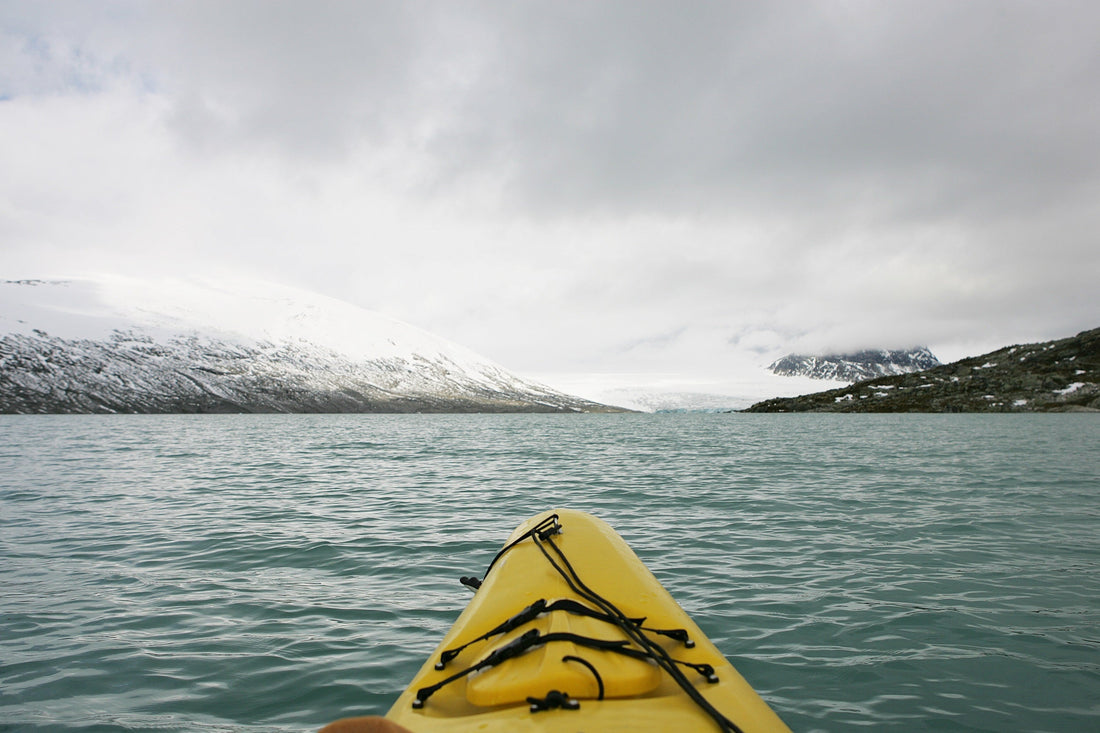Wintertime creates a whole new kayaking experience. The water and environment are transformed by cooler temps, especially if you get snow or ice. These elements can make lakes and rivers more challenging to navigate, but as long as you’re equipped with the proper winter kayak gear and safety techniques, it will be smooth sailing for you.
Kayak Safety Tips for Icy Conditions
Being out on the water takes extra preparation if your area has recently experienced snowy or icy weather. Whether you like going out on the lake during the winter or paddling along a river, you should take extra precautions before heading out on your trip to stay safe and enjoy your adventure. Here are some general best practices for cold water and ice safety to help you prepare:
Before You Go Kayaking:
Select a smart route.
Scout your entry and exit points. Depending on the weather, your usual entry and exit points could be iced in. Turbulent, shallow water tends to be less prone to freezing over, so check for rivers with a consistent current or lakes that are fed by rivers so you can get in and out of the water safely. Also, ensure your local paddle spot isn’t restricted by local rules, launch hours, or permit restrictions.
Check the weather.
Be prepared to respond to sudden changes in the weather. If a storm is coming in, be ready to cancel or postpone your paddle. Watch the skies and winds as well, and cut things short if conditions turn threatening. It is always better to come home safely rather than risk the need for rescue or endanger your life.
Practice re-entry skills.
A capsize in winter temperatures can quickly turn deadly. Make sure that you are practiced up on your re-entry skills so you can rapidly return to your kayak before negative effects kick in. It is also wise to have a “get-out” plan if things turn south. Have multiple locations for exiting the water and you might consider staying close to shore or easy outs.
Let someone know your plan.
Whether you are on your own or with a group, always leave a float plan behind with someone on land. Make sure you check in with someone before you go so, they know where you’re headed and how long you should be.
On the Water Kayaking:
Always wear your PFD.
This goes for any time you’re on the water, but particularly in cold weather a PFD will help you conserve energy and easily stay afloat and positioned for re-entry if you take a spill.
Prepare to get wet.
Whether it’s splashes from your paddle or the unanticipated dunk, you need to be prepared to confront freezing water temps. Layer up with insulating, moisture-wicking fabrics, and consider investing in a wetsuit as an additional outer layer to further protect the cold water from seeping in.
Wear proper clothing.
Make sure to wear layers and keep a moisture-wicking layer close to your skin. Consider investing in a dry suit if you plan to paddle in the most extreme temperatures. Be sure to protect your head and hands.
This goes for all kayakers, but particularly if you’re angling and not moving around as much, the more heat you can retain the better. Take care of your feet too and get some neoprene booties.
Prep a dry bag.
In addition to what you layer up in, it is wise to bring a dry bag with a change of clothing - for an emergency dunking or even the ride home. Clean, dry, warm clothes are a welcome - sometimes life-saving - addition to your trip.
Your dry bag should also include safety equipment like a first aid kit, emergency signaling device, snacks & water, and sun protection (just because it is cold doesn’t mean you can’t burn).
Check before bearing down on ice.
Winds and currents can cause sections of ice to break loose or float off sporadically, especially in large lakes. This can cause your path to narrow or become obstructed despite your best scouting efforts.
You can brace and bear down on the ice with your paddle to scuttle your kayak along in this situation, but make sure it’s white or clear in color–ice that’s black in appearance is typically weak and can cause you to capsize if you bear down on it, and it gives way.
Hone your paddling technique.
When paddling in cold water, paddle in a controlled manner. A consistent paddling stroke is warming to your system and also prevents excessive splashing. Avoid aggressive strokes that could destabilize your ‘yak. And keep your strokes close to the hull to minimize dripping water. Also, be sure to keep your paddle secure at all times. (It might be wise to invest in a backup paddle secured to your kayak.)
Paddle in pairs.
With the heightened challenges winter kayaking brings, it is helpful to have someone else with you while you’re paddling in the cold. Not only are they a morale boost, but they can also help out if anything goes wrong on the trip.
Consider the limits of the weakest paddler and be prepared to cut things short if needed. Talk about expectations, routes, and rescue plans before heading out.
Know your limits.
This can’t be overstated! Paddle within your capabilities. With ice comes more chilling temps, and you can burn out if you aren’t prepared for the cold to sap your energy faster. Consider this when planning the length of your trip, and make sure you bring some snacks and a hot drink to refuel on your journey.
It can seem intimidating to kayak in winter weather, but don’t let that stop you from pursuing this sport year-round. Prepare and plan as much as possible beforehand, rely on your experience and instincts out on the water, and you’ll have a fun and safe trip!

